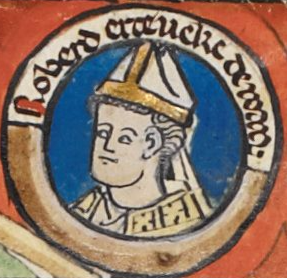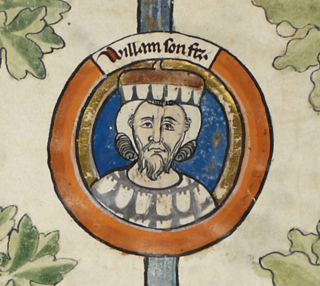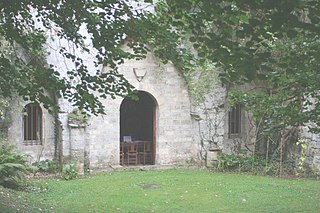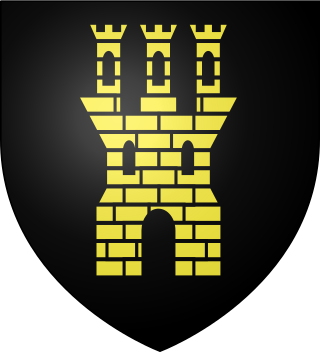Related Research Articles

William the Conqueror, sometimes called William the Bastard, was the first Norman king of England, reigning from 1066 until his death. A descendant of Rollo, he was Duke of Normandy from 1035 onward. By 1060, following a long struggle, his hold on Normandy was secure. In 1066, following the death of Edward the Confessor, William invaded England, leading an army of Normans to victory over the Anglo-Saxon forces of Harold Godwinson at the Battle of Hastings, and suppressed subsequent English revolts in what has become known as the Norman Conquest. The rest of his life was marked by struggles to consolidate his hold over England and his continental lands, and by difficulties with his eldest son, Robert Curthose.

Herleva was an 11th-century Norman woman known for having been the mother of William the Conqueror, born to an extramarital relationship with Robert I, Duke of Normandy, and also of William's prominent half-brothers Odo of Bayeux and Robert, Count of Mortain, born to Herleva's marriage to Herluin de Conteville.

Robert I of Normandy, also known as Robert the Magnificent and by other names, was a Norman noble of the House of Normandy who ruled as duke of Normandy from 1027 until his death in 1035. He was the son of Duke Richard II; the brother of Duke Richard III, against whom he unsuccessfully revolted; and the father of Duke William who became the first Norman king of England after winning the Battle of Hastings in 1066. During his reign, Robert quarrelled with the church—including his uncle Robert, archbishop of Rouen—and meddled in the disorder in Flanders. He finally reconciled with his uncle and the church, restoring some property and undertaking a pilgrimage to Jerusalem, during which he died.

Robert, Count of Mortain, first Earl of Cornwall of 2nd creation was a Norman nobleman and the half-brother of King William the Conqueror. He was one of the very few proven companions of William the Conqueror at the Battle of Hastings and as recorded in the Domesday Book of 1086 was one of the greatest landholders in his half-brother's new Kingdom of England.

Richard II, called the Good, was the duke of Normandy from 996 until 1026.
Alan III of Rennes was Count of Rennes and duke of Brittany, by right of succession from 1008 to his death.
Goda of England or Godgifu or Gode was the daughter of King Æthelred the Unready and his second wife Emma of Normandy, and sister of King Edward the Confessor. She married firstly Drogo of Mantes, count of the Véxin, probably on 7 April 1024, and had sons by him:

William III of Ponthieu also called William Talvas. He was seigneur de Montgomery in Normandy and Count of Ponthieu.
Enguerrand II was the son of Hugh II count of Ponthieu. He assumed the county upon the death of his father on November 20, 1052.

William of Talou, Count of Talou (Arques) was a powerful member of the Norman ducal family who exerted his influence during the early reign of William the Conqueror Duke of Normandy.

Robert II, Archbishop of Rouen, and Count of Évreux was a powerful and influential prelate, and a family member of and supporter of five dukes of Normandy.

William Longsword was the second ruler of Normandy, from 927 until his assassination in 942.

Herluin de Conteville was the stepfather of William the Conqueror and the father of Odo of Bayeux and Robert, Count of Mortain, both of whom became prominent during William's reign. He died in 1066, the year his stepson conquered England.

The Château de Falaise is a castle from the 12th-13th century, located in the south of the commune of Falaise in the département of Calvados, in the region of Normandy, France. William the Conqueror, the son of Duke Robert of Normandy, was born at an earlier castle on the same site in about 1028. William went on to conquer England and become king, and possession of the castle descended through his heirs until the 13th century, when it was captured by King Philip II of France. Because of his association to the location it is also known as Château Guillaume le Conquérant or William the Conqueror's Castle.

Mauger was born around 1019 near Dieppe. He was the younger son of Richard II, Duke of Normandy, and his second wife, Papia of Envermeu.
Mabel de Bellême was a Norman noblewoman. She inherited the lordship of Bellême from her father and later became Countess of Shrewsbury through her husband. She was a member of the House of Bellême.

The House of Bellême also referred to as the Family of Bellême was an important seigneurial family during the 10th through the 12th centuries. Members of this family held the important castles of Bellême, Alençon, Domfront and Sées as well as extensive lands in France, Normandy and Maine.
Walter Gautier Giffard, Lord of Longueville, Normandy, was a Norman baron, a Tenant-in-chief in England, a Christian knight who fought against the Saracens in Spain during the Reconquista and was one of the 15 or so known companions of William the Conqueror at the Battle of Hastings in 1066.
Ralph of Gacé was a member of the House of Normandy who played an influential role during the minority of William the Bastard, prior to his conquest of England. Ralph was the lord of Gacé and other estates in Normandy.
Guimond de Moulins was a lord from Normandy in the 11th century, and the progenitor of the great Italo-Norman nobility family De Molisio, which is said to have given its name to the region of Molise in Southern Italy.
References
- Crouch, David (2002). The Normans - The History of a Dynasty.
- de Bouard, M. (1984). William the Conqueror.
- Douglas, David C. (1963). William the Conqueror .
- Freeman, Edward A. (1870). The History of the Norman Conquest.
- van Houts, Elisabeth M. C. (1986). "The Origins of Herleva, Mother of William the Conqueror". The English Historical Review. 101 (399): 399–404. doi:10.1093/ehr/ci.cccxcix.399.